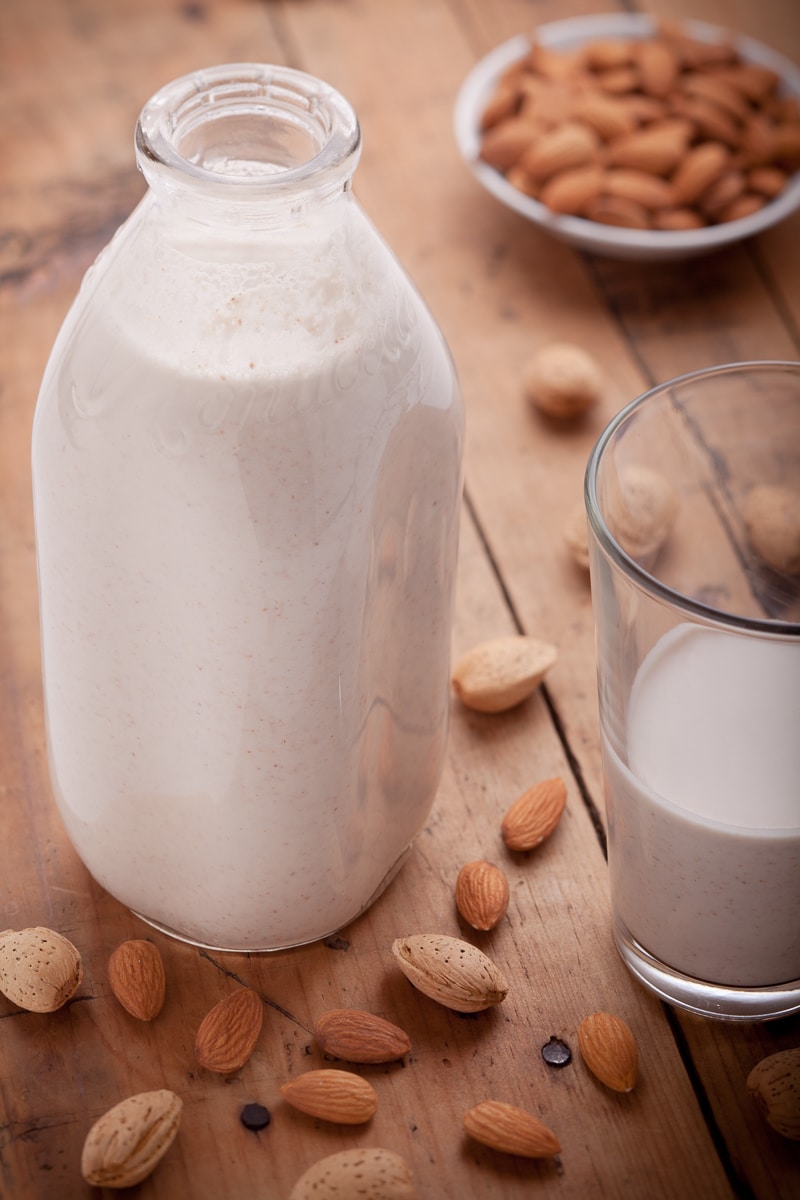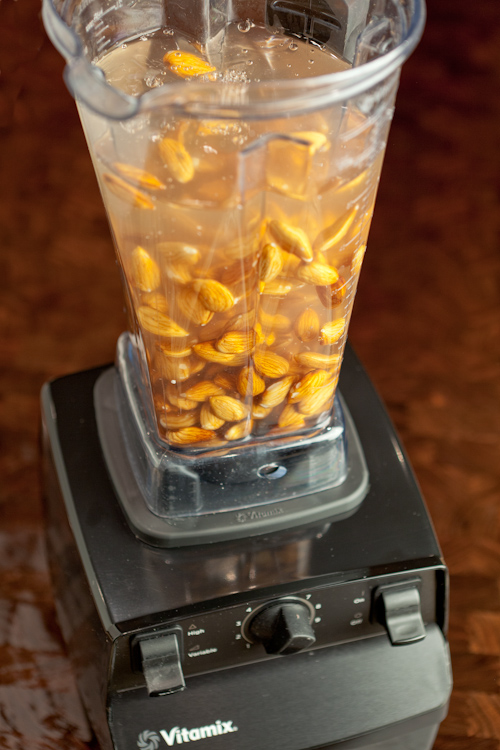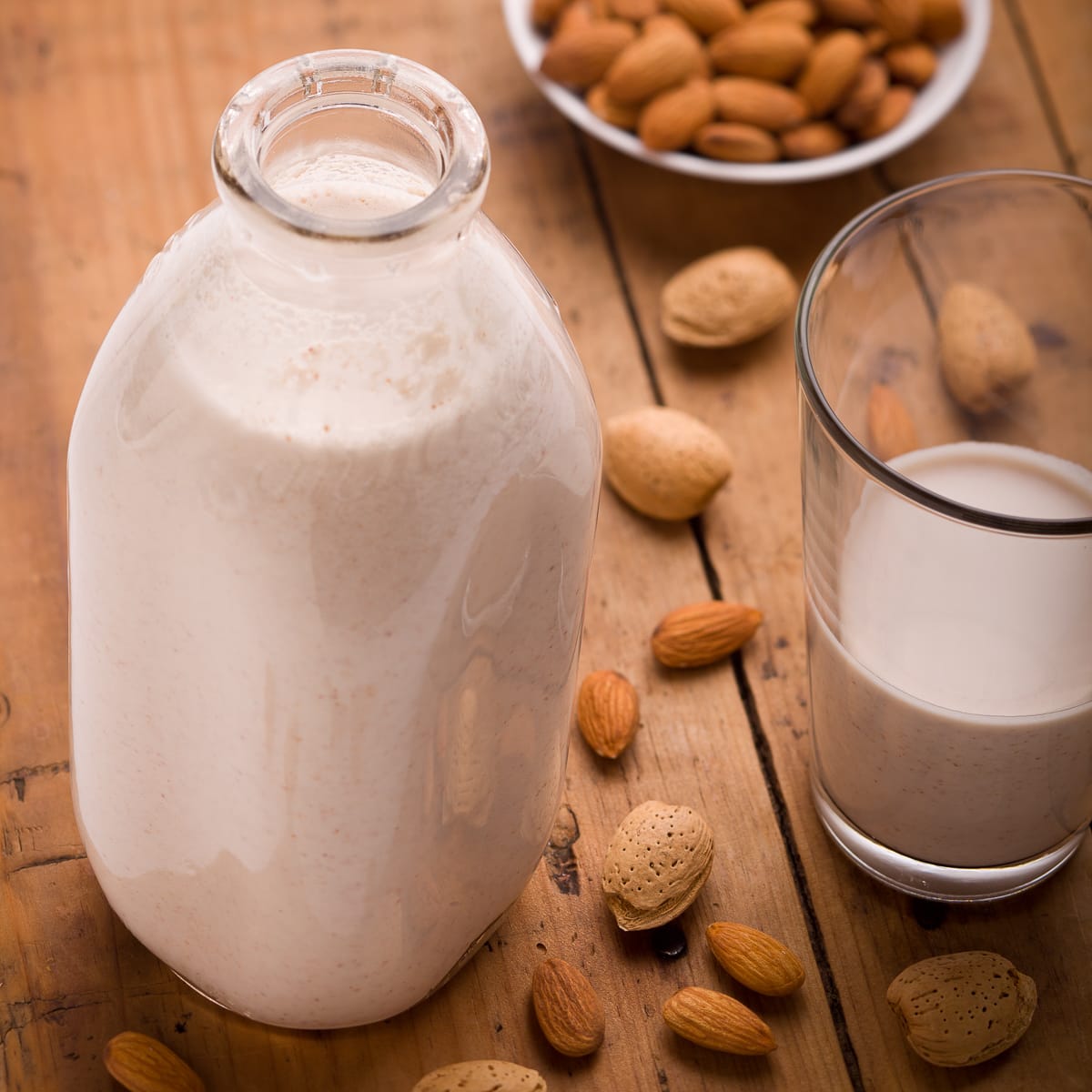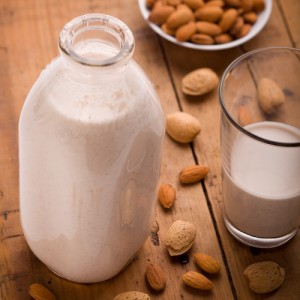If your goal is eating more healthfully this year by adding more unprocessed and whole foods to your diet, here is an easy, healthy recipe for homemade almond milk. What isn’t better homemade?

Eating a healthy breakfast starts your day off right and sets you up for an energy-filled, successful day. Studies show kids do better in school when they eat breakfast, so that must work for adults too. I wanted a non-dairy milk for smoothies, so this is what I make. Much better made at home.
Jump to:
Homemade vs. Store Bought
Homemade beats the stuff in a box or carton, which can be processed with additives you don’t want. It’s so simple to make, so why not make your own? Since I started making homemade almond milk, a lot has changed with what you can buy. Today there are some decent brands, but I prefer to do it myself.
Breakfast Smoothie
We usually start the day with a breakfast smoothie based on protein powder, frozen fruit and milk. You can find the recipe at this link. I’ve switched from using cow’s milk to almond milk. It’s one small part of my decision to include more plant-based options in our diet.
Why Almonds?
Almonds are considered the most nutritious of nuts. From a nutrition standpoint, almonds are a rich source of protein containing fiber, omega-3 and 6 fatty acids, vitamin E, magnesium, calcium, and zinc. That, and I love the flavor of almonds. I snack on them every day.
Soy Milk vs Almond Milk
Soy is a controversial ingredient whose health benefits are debated. One benefit is it's high-protein. One, negative, soy is a common food allergy or sensitivity, and gives many people digestive upset.
"On one hand, it’s rich in nutrients, and diets containing it appear to be linked to health benefits, such as lower blood sugar levels, improved heart health, fewer menopause symptoms, and perhaps even a lower risk of certain cancers" reports this article.
On the other hand, some are concerned about soy and thyroid function, increasing breast cancer risk, or the effects of soy's phytoestrogens.
Unless you buy organic soy, it is GMO (genetically modified) and that's a whole other conversation. I avoid GMO's completely. It's up to you to eat what is best for you. If you enjoy soy milk, I suggest not drinking it every day. Switch it up with other non-dairy milks such as almond milk, cashew milk and coconut milk.
With all alternative milks, buy unsweetened and unflavored and add what you want for quality and control.

Simple to Make
Almond milk is a great alternative to cow’s milk. We use it every morning for our breakfast smoothies. It’s good over cereal, oatmeal, in soups, or just for plain drinking. The best part is almond milk is simple to make.
First, soak raw almonds in clean filtered water overnight. Soaking almonds unleashes their full nutritional benefit and makes them easier to digest. It also makes them easier to blend.
Almond to Water Ratios
Depending on the capacity of your blender and your volume needs, try these ratios. The water listed is not the soaking water, but the final water used to make the milk.
- 9 ounces almonds to 6 cups water
- 6 ounces almonds to 5 cups water
- 4 ½ ounces water to 3 cups water
Soak and Drain
After soaking almonds, drain off the soaking water and rinse. Almonds contain enzyme inhibitors that can interfere with digestion, so toss the soaking water and use fresh water to puree your almonds into milk in a high-speed blender. That’s it.
To Strain or Not
Some recipes strain the almond milk through a nut milk bag for a smoother texture. I do not. Do what suits you best. We like the texture of un-strained almond milk. It’s thick and rich. It will keep for about 3-4 days in the refrigerator. Upon sitting, it can get a little foamy looking on top. Just stir, shake or whisk before using. If you let it sit too long and it smells sour, toss it.
To Sweeten or Not
If you want it sweetened, add a little natural sweetener like brown rice syrup, liquid stevia, maple or honey. You can also add a little vanilla extract or almond extract for more flavor.

Tips For Buying Raw Almonds
While a 2007 USDA law requires all almonds grown in the United States or Mexico to be sanitized or pasteurized, there are two methods used: steam pasteurization and Propylene gas (PPO). You want steam pasteurized.
Steam pasteurization is non-toxic and does not kill the nut. It's done with a short burst of steam that sanitizes the surface of the nut only. Steam pasteurized almonds will sprout, so they are still alive. Look for the words steam pasteurized somewhere on the package. If nothing is listed, call the producer and ask.
The other method using Propylene Oxide (PPO) gas is industry standard because it is cheaper. PPO gas is classified by the U.S. Environmental Protection Agency (EPA) as a probable human carcinogen. Not too appetizing or healthy for your family. Here are the almonds I buy.
For Other Plant-based Milk Options
For another plant-based milk option try my pumpkin seed milk, cashew milk, or quick homemade coconut milk.
📖 Recipe

Homemade Almond Milk
Equipment
Ingredients
- 6 ounces raw almonds
- Filtered water to cover the almonds for soaking
- 5 cups filtered water
Options
- A splash of vanilla or almond extract optional for flavoring
Instructions
- Place almonds in container and cover with water. Cover and refrigerate for 12-24 hours. Strain off soaking water. Pour soaked almonds and 5 cups fresh filtered water into a high-speed blender with a tight fitting lid and process for 30-60 seconds on high. Start slow and build up the speed. Refrigerate and use within 3-4 days. Stir each time you use as it settles.
Goldie says
Hi, thanks for the recipe. I never make it by myself.now i want to make it by myself.
1. Must i peel the skin before blend it?
2. Is there any difference for the finale taste & texture between peel the skin & not peel it? I bought raw almond with skin.
3. Must i boil the milk?if yes, how long should i boil it? How high is the temperature to boil it?
Thanks
Sally Cameron says
Hi Goldie. Glad you are making almond milk at home rather than buying it. Much better! This is a very simple and easy recipe. You do not peel or skin the almonds and you do not boil the milk. Just soak the raw almonds, drain, and puree with fresh filtered water about 90 seconds. That's it. Refrigerate. it will last a few days. I make it several times a week.
Julie Richter says
How much vanilla extract would be best to use?
Sally Cameron says
Its really to your taste Julie. Start with a teaspoon and taste. Add from there. I love vanilla, so I might double that. You can use extract or pure ground vanilla bean. Hope that helps.Let me know.
Gwynn says
Could you roast the almonds first? This seems like it would enhance the taste. Or is there a nutritional detriment to roasting?
Sally Cameron says
Hi Gwynn. I would not roast the almonds. Roasting equals heat equals not the same nutritional benefits as raw. The taste is great, fresh and clean with raw almonds. Hope you enjoy it. I make a batch about 3 times a week. For the best almonds and best price. I ship my almonds from a grower in CA. I buy 10 pounds at once and get free shipping too. Seems like a lot of almonds, but as we snack on them plus use them for milk, we go through that much about every 3 months, just two of us. Check out http://www.california-almonds.com
Adrienne says
Sally, Can I use a food processor? or blender? Don't have a Vitamix.
Sally says
Unfortunately not. A food processor won't do the job. You really need a blender. Get the best one you can. If the capacity is smaller than a Vitamix, which has a 2-quart capacity, you may need to blend in half batches. Another option, you can get a reconditioned Vitamix with free shipping from the ad on my home page. The reconditioned models have just been used for shows. They are a great deal! It's what I would do to save money. Check it out. I know even then, they are $329 but they are a terrific investment. I could not live without mine. It will last forever!
Shayna says
really nice article- thank you! I've been from organic dairy to soy now to almond milk and I'm excited to try this. You noted about being able to purchase raw, unpasturized almonds directly from farmers- any tips for storage, or how long will the raw almonds keep for since they're not pasturized. Thanks!
Sally says
Hi Shayna. Thanks for your comment and question. The organic almonds I purchase, and I buy 6 pounds at a time, are currently from D&S Ranches. They come vacuum sealed in 1-pound packs. I store them in the pantry until opened, then in the refrigerator. We go through them so fast I don't know how long they would actually last. A long time I would think.
Sonja says
I'm not sure if anyone is interested, but I just watched a documentray called, "Queen of the Sun - What are the Honeybee's Telling Us", and there was a fascinating section on the California almond market in it. I just thought it might be something worth noting. I'm glad to read that most people are going to their local markets and independent farmers though! It's a little harder to get fresh organic produce through the winter months (and you pay a premium at the stores for it) up here in Canada...but I make a huge effort to do so for my family, and for my local economy. Thanks for the tips on the organic natural almonds as well. I'll definately look into it! 🙂
Celia says
Love this post! Thank you for the info... I used your link to buy from Hopkins AG. Have you tried (gently) heating the unstrained almond milk? Does it separate or curdle? I've got a "wand" frother, so I don't have to steam it, but warming the milk makes a much nicer latte. 🙂
Sally says
Thanks for your comment. Glad it's helpful. I've never tried warming it for a latte but have always wondered. If you try it, please comment back and let everyone know!
Celia says
Okay - just made my first batch with the Hopkins AG almonds, and warmed and frothed it just out of the blender.
The warming didn't make it separate, and the frothing worked, nominally, but you don't really get a head of froth on it... just a frothy texture throughout.
Tomorrow morning I'll see if adding the espresso makes it curdle.
sue says
Hi Sally,
I noticed your recipe is to reused the soaked water. I've read that the soaked water
should be throw out & new water to be use every 8 hours for soaking. Rinse before
putting in blender and then add fresh water.
Sally says
Hi, in my research I've found many opinions on making almond milk and soaking almonds. In the fridge or at room temp, using the water or not, salted water or not. Recently I've decided, after doing more research and checking with a friend who is a chef and raw vegan expert, that tossing the water after soaking and using fresh water to create the "milk" could be beneficial, if you want to take that step. Why? Because the water contains the leached-out enzyme inhibitors present in the brown skins of almonds. Enzyme inhibitors protect the almond until it needs to germinate (grow), which might limit the nutrient value that you can absorb, or make it harder to digest. I've never had a digestive issue using the soaking water to make my almond milk. But point taken, I will make a note in the recipe. Nice thing about blogs, you can add new information and insights. Thanks. Hope that helps?